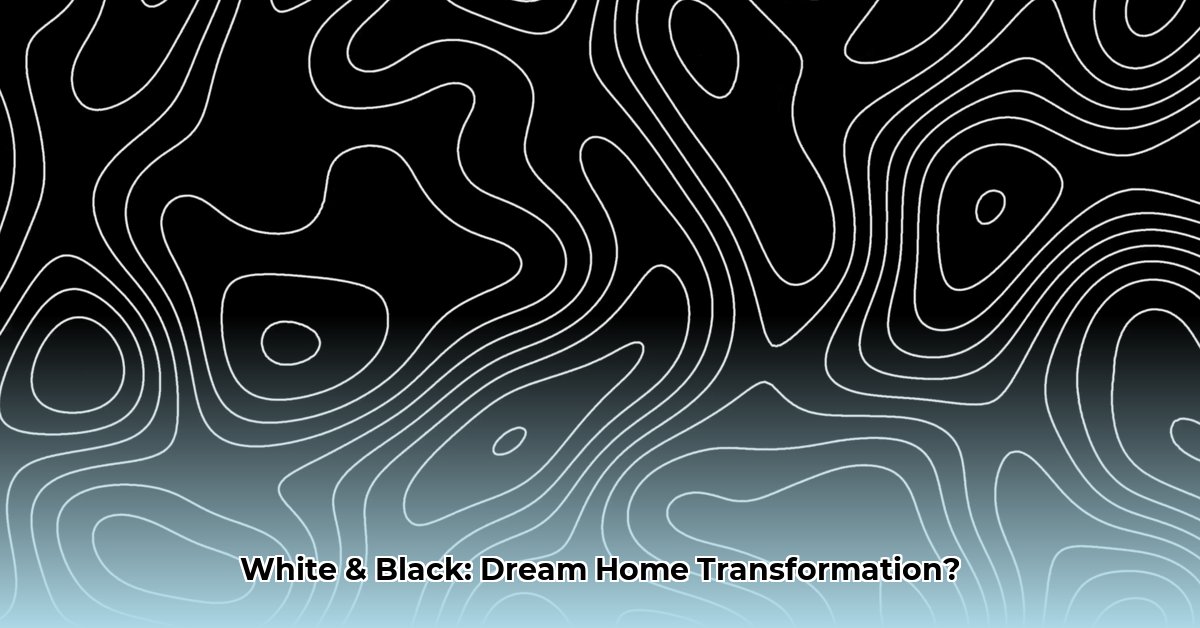Want a house that looks amazing? A classic white house with black trim is the perfect way to achieve that timeless, elegant look. This guide will show you exactly how to do it, from choosing the right shades of paint to making sure it stays looking great for years. We’ll cover everything you need to know, step-by-step, so you can easily create a stunning home exterior that will increase your curb appeal and even boost your home’s value. For added warmth, consider installing a [beautiful fireplace](https://turthledeep.com/wall-fireplace-mount/). Let’s get started!
White Houses with Black Trim: A Design Guide
Looking to elevate your home’s exterior? Discover the allure of white houses with black trim, a design choice celebrated for its timeless appeal and sophisticated style, proving surprisingly attainable.
Finding the Perfect Shades of White and Black for Exterior Design
The nuance in shades of white and black is paramount. A creamy off-white evokes warmth, ideal for creating an inviting atmosphere, while a bright, crisp white offers a modern, sleek aesthetic. Similarly, a deep charcoal black lends drama, whereas a softer, brownish-black provides a more relaxed feel. It’s crucial to evaluate how different shades interact with your home’s architectural style and respond to varying light conditions to achieve the ideal palette. Consider paint samples in different lights – morning sun, afternoon shade – to see how the colors change and align with your vision.
Pro Tip: Obtain paint samples and apply them to a large board. Move the board around the exterior of your house to see how the colors look in different lighting conditions throughout the day.
The Art of Balance: Making Your Trim Shine
Black trim serves as a visual highlight, akin to jewelry, accentuating architectural features like windows, doors, and rooflines. Striking the right balance prevents the trim from being overwhelming, ensuring the accents enhance without dominating the overall aesthetic. Too much black can feel overwhelming. Too little, and the impact is lost. The key is balance.
Design Consideration: For smaller homes, consider using thinner trim for a subtle accent. For larger homes, bolder, wider trim creates a statement.
Choosing the Right Stuff: Material Selection for Longevity
Durability is crucial for maintaining the aesthetic appeal of your home. Investing in high-quality exterior paint, specifically formulated for diverse weather conditions, is essential, especially for black trim which tends to absorb more heat. Consider the impact of your window choices on both style and budget, opting for materials and designs that complement your home’s architecture while ensuring longevity.
Material Options:
* Wood: Classic look, requires regular painting/sealing.
* Vinyl: Low maintenance, weather-resistant, but can look less premium.
* Aluminum: Durable, rust-resistant, modern aesthetic.
* Fiber Cement: Durable, versatile, mimics wood grain, fire-resistant.
Adding Depth and Texture: Beyond Just Paint for Visual Appeal
Incorporating textures such as stone, brick, or wood introduces visual depth and interest, enhancing the monochrome palette. Consider how strategically placed landscaping softens the house’s lines and creates an inviting backdrop, further elevating your home’s curb appeal.
Texture Ideas:
* Stone veneer on the foundation or porch columns.
* Wood shingle accents in gable areas.
* Brick pathways or patios.
Your Step-by-Step Transformation Guide
Ready to enhance your home’s exterior? Follow these steps to achieve a stunning transformation:
1. Know Your Home: Evaluate architectural strengths to accentuate.
2. Paint Sample Party!: Test various shades of white and black under different lighting.
3. Choose Wisely: Invest in durable, high-quality materials for longevity.
4. Plan Your Attack: Develop a meticulous painting plan, considering professional help for larger projects.
5. Landscaping Magic: Incorporate landscaping to complement your color scheme and enhance curb appeal.
6. Before & After Brag Session!: Capture the transformation to showcase the impact of your design choices.
Project Timeline: Depending on size and complexity, allow 1-3 weeks for this project.
Weighing the Pros and Cons: Is This Look Right for You?
A white house with black trim offers both advantages and considerations:
| Feature | Pros | Cons |
|---|---|---|
| Color Combination | Classic, versatile, enhances architectural detail, boosts curb appeal | Might seem stark if not balanced correctly; requires careful planning |
| Maintenance | Relatively easy to maintain (with good quality materials) | Requires periodic touch-ups, especially the black trim, which fades faster. |
| Cost | Highly variable depending on your material selection | Premium materials often come with a higher price tag. |
| Resale Value | Usually increases a home’s perceived value | Personal taste varies; color might not appeal to all potential buyers. |
With careful planning and material selection, this timeless combination can transform your home into a stylish showstopper.
How to Choose the Best Black Trim Color for White House Exterior
Choosing the most suitable shade of black trim for a white house exterior requires careful consideration of light reflectance value (LRV), undertones, and your home’s orientation.
Step 1: Understanding Light Reflectance Value (LRV)
Light Reflectance Value (LRV) indicates how much light a color reflects; aim for a white with an LRV of 80-85 for a balanced brightness. Classic whites include Benjamin Moore’s “Chantilly Lace” (LRV 90.04) or Sherwin-Williams’ “Pure White” (LRV 84). For black trim, selecting an off-black with an LRV above 5 softens the contrast, creating a harmonious visual effect.
LRV Insight: A lower LRV means the color absorbs more light and appears darker.
Step 2: Choosing Your White: Undertones Make All the Difference
The perfect white is subjective, but undertones matter. Warmer whites (with hints of beige or greige) feel cozy and inviting. Cooler whites (leaning towards gray or blue) can feel modern and sophisticated. Imagine the difference between creamy vanilla and crisp winter snow. Which best fits your style and surrounding landscape? Experiment with samples in different lighting conditions.
Warm White Examples: Benjamin Moore’s “White Dove,” Sherwin-Williams’ “Alabaster.”
Cool White Examples: Sherwin-Williams’ “Extra White,” Benjamin Moore’s “Decorator’s White.”
Step 3: Selecting Your Black Trim: Beyond “Just Black”
Venture beyond true black for trim, and explore off-black shades that offer a more balanced, elegant look.
Off-Black Shades:
* Charcoal Gray: Softens the contrast.
* Iron Ore: A dark gray with brown undertones.
* Peppercorn: A muted black with a hint of gray.
Step 4: The Impact of Your Home’s Orientation
The direction your house faces affects how light interacts with colors, influencing the choice of shades to ensure the exterior looks its best in all conditions.
- North-Facing: Opt for warmer whites to counteract cool shadows.
- South-Facing: Cooler whites work well, as they won’t appear too harsh.
- East-Facing: Observe morning light – warmer whites may glow.
- West-Facing: Consider how colors look in the harsh afternoon sun.
Step 5: Paint Quality: An Investment Worth Making
Investing in high-quality, UV-resistant exterior paint is essential for protecting your home and maintaining vibrant colors for years, preventing the need for frequent repainting.
Recommended Brands: Sherwin-Williams, Benjamin Moore, Behr.
Step 6: Test, Test, Test!
Before committing to a large project paint samples are your best friend. Paint several large swatches on different sides of your house. Observe how they look throughout the day, in varying light conditions. This will give you the best idea of how your chosen colours will look and feel once the project is complete.
Sample Size: Use at least a 2’x2′ swatch for accurate color representation.
Elevating Curb Appeal with White Houses and Black Trim in Coastal Settings
Enhancing curb appeal in coastal settings involves selecting the right white shades, ensuring trim durability, accentuating architectural details, and integrating landscaping and exterior lighting to create a visually striking exterior.
Choosing the Right Whites and Blacks
When selecting the perfect whites and blacks for a coastal home, consider the architectural style and surrounding landscape to ensure a harmonious and visually appealing result.
Coastal White: Opt for a bright white with a hint of blue or gray to reflect the sea and sky.
Coastal Black: Choose a charcoal black or deep navy to complement the coastal elements.
Material Matters: Trim Durability
Durability in trim material is paramount, especially in coastal environments where salt air and moisture can cause significant wear. Aluminum or vinyl offer excellent resistance to corrosion.
Alternative Materials:
* PVC trim: Moisture-resistant, durable, and paintable.
* Fiberglass windows: Resists warping and corrosion.
Accentuating Architectural Details
Black trim skillfully highlights architectural details, enhancing visual interest and creating depth. Careful trim placement elevates the design without overwhelming it.
Trim Ideas:
* Black shutters.
* Black window frames.
* Black pergola.
Integrating Landscaping and Exterior Lighting
Your landscaping and lighting
- Why an App Appeared on My Phone Unexpectedly - November 22, 2025
- How to Stop Unwanted Apps from Automatically Downloading on Android - November 21, 2025
- Why Are Android Games Installing Themselves on Your Phone? - November 20, 2025










